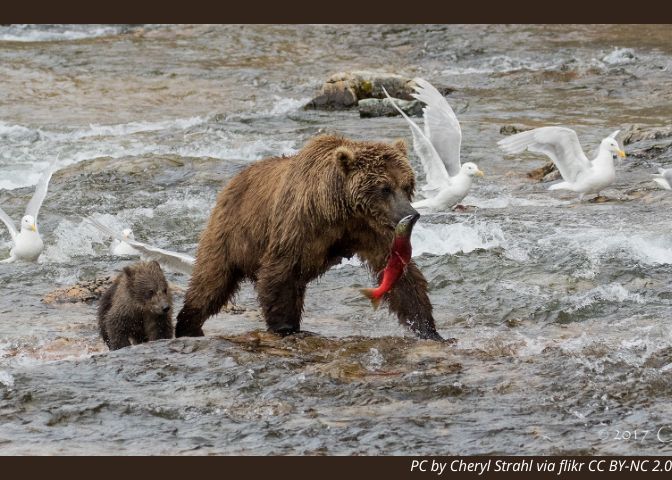America’s Salmon Forest
The Tongass is the only habitat in the world that supports all five species of Pacific salmon

The character of the Tongass National Forest is inextricably linked to the waters around it and the salmon that live there. Salmon are born in interior Tongass rivers and stay in the surrounding freshwater area for one to three years before migrating to the Pacific Ocean. They then spend two to five years in the ocean before returning to the massive forest’s waters to spawn. Without the Tongass, these salmon have no home.
Since its passage in 2001, the “Roadless Rule,” which protects 9.3 million acres of the Tongass from road building and logging, has been a safeguard for these salmon. However, the Trump administration repealed these protections in October 2020. Roadless protections absolutely must be reinstated by the Biden administration because these protections are elemental to the health of the Tongass and its salmon population.
Locals get this immutable fact. For instance, local fishermen were some of the loudest opponents to the Trump change. They recognized that when protections were removed and the Tongass was opened to construction, waterways were poised to become even more dangerously clogged. People in this region have long memories and they know that existing logging roads from the mid-1900s have already hindered the salmons’ ability to swim upstream to spawn and return to the ocean for decades. Sediment from construction cuts off salmon runs and pollutes the waters.
It takes a long time — as much as three decades — to reverse the damage caused by logging. Even attempts to mitigate this harm, like concrete passages under roads, can cause blockages and high-velocity downstream currents. With that in mind, the threat of new road construction strikes tremendous fear that salmon populations would be put at even risk.
“A very small minority is going to make a lot of money, and the majority are going to be hurt,” said Lance Preston, a salmon troller in Sitka, Alaska, following the announcement about the potential impact of new roads.
This would be untenable for Southeast Alaska’s local community, which is reliant on healthy salmon populations. The region’s economy is buoyed by salmon trawling with 25% of the entire west coast’s catch coming from this small area. Sport fishing also makes up a large portion of their tourism sector in the area.
As such, the Tongass National Forest is often referred to as America’s Salmon Forest. The Tongass is the only habitat in the world that supports all five species of Pacific salmon: King, Sockeye, Coho, Pink, and Chum. In a poetic twist, salmon die after spawning and their nutrients are returned to the streams that gave them life. Salmon literally end their lives as nourishment for trees with roots absorbing nitrogen as they decompose. These deceased fish also provide food to other animals in the Tongass, such as predatory birds. The process is awe-inspiring and cyclical. Interrupting it for perceived short-term economic benefit ignores the importance of salmon to nature, animals and people.
Salmon fit into a fragile and unique web of life that should not be altered. Aside from humans, another species that relies on healthy salmon populations is the grizzly bear. The Tongass supports the largest density of brown bears in the world, in large part due to the abundant food source. In fact, an island in the Tongass is home to more brown bears than the entire lower 48 combined. In addition to bears, salmon are a key part of thriving populations of wolves, migratory birds, seals, otters, whales and the largest concentration of bald eagles in the world. The eagles feast on chum salmon. Each species relies on one another to survive.

Thankfully, the Biden administration recently announced its intention to reinstate protections to the Tongass, as well as their commitment to conserve 30 percent of the nation’s land and water by 2030. That said, before those protections are restored, there will be a public comment period where citizens can voice their opinions about their intended action.
During their recent announcement the U.S. Department of Agriculture’s communications director referenced a previous comment period, saying: “The majority of comments recognized the important role of the Tongass National Forest and roadless areas protections to tourism, fishing, recreation, indigenous cultures and the uniqueness of the temperate rainforest.” We must be sure that the comments submitted during this comment period are also overwhelmingly in favor of restoring protections.
Topics
Authors
Mitchell Ukropina
Find Out More

Our 2024 priorities in the states

500,000 people call for mature and old-growth forest protections

When it comes to trees, President Biden makes Earth Day count

